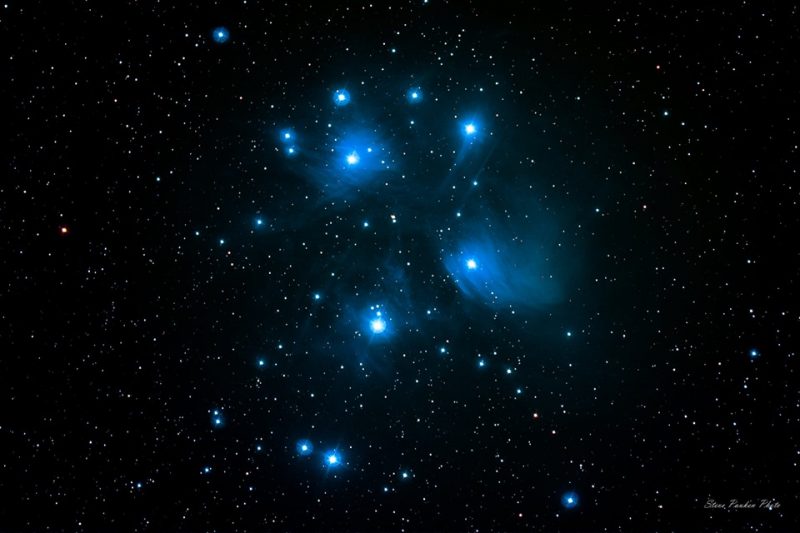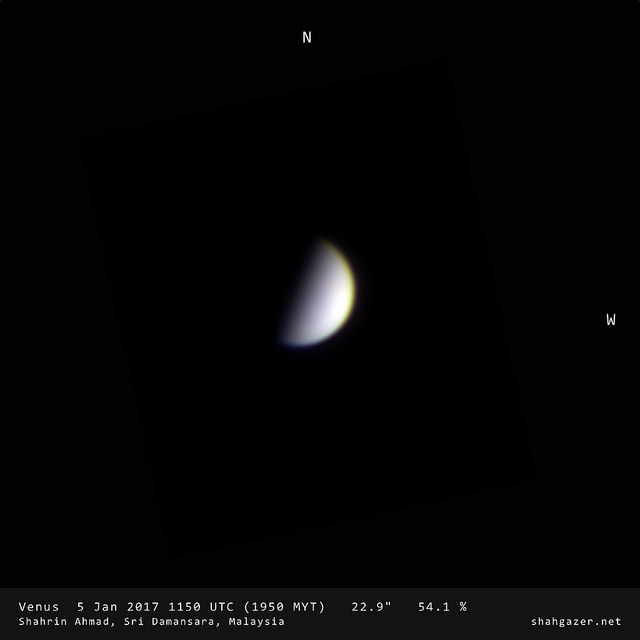
The Pleiades Star Cluster as seen in a time exposure image.
The splotches of gas surrounding the star are all part of the Maia Nebula,
a gaseous "cloud" through which the cluster is currently moving. The stars illuminate this nebula like fireflies in a fogbank. The Maia Nebula is classified as a "reflection nebula," or one that is rendered visible by the light of embedded stars.
MONDAY, OCTOBER 25: MERCURY AT GREATEST WESTERN ELONGATION
Just a quick review:
-when a planet is at greatest western elongation, it will be visible in the eastern pre-dawn sky.
-when a planet is at greatest eastern elongation, it will be visible in the western evening sky.
One will find Mercury in the early morning. In fact, this is the best time of month to find the first world. (See "Planet Watch.")
THURSDAY, OCTOBER 28: VENUS AT DICHOTOMY
Venus at what?
Venus at Dichotomy, or, if you want less obfuscation, theoretical dichotomy. Or, if you prefer the type of English that is served with cookies instead of crumpets, Venus is half lit up.

Venus at dichotomy or half illumination
Galileo knew his soul was imperiled when he first viewed Venus through a telescope and observed its phases. That observation provided compelling evidence in support of the Sun-centered (heliocentric) as opposed to the Earth-centered (geocentric) model that the empowered elite preferred. Provided you hold your soul light, you can observe Venus' phases yourself through any telescope. Look at it today and you'd see a "half Venus." Like the moon, the two inferior planets exhibit a phase cycle. Although, as neither Mercury nor Venus is ever on the far side of Earth relative to the Sun, neither one will ever appear "full." Today, Venus is just in the right position relative to the Earth and Sun to be half-lit. One won't actually notice this phase until one observes Venus telescopically. To the unaided eye, Venus appears as a brilliant dot in the western evening sky.
THURSDAY, OCTOBER 28: LAST QUARTER MOON
Hey, the moon is also at theoretical dichotomy, or half illuminated.
FRIDAY, OCTOBER 29: VENUS AT GREATEST EASTERN ELONGATION
Remember what we said earlier about Mercury's greatest western elongation? If the elongation is western, the planet's in the easten sky and if it is an eastern elongation, the plane is in the west?
Well, Venus is the brilliant beacon in the western evening sky tonight! At this elongation, it will be 47 degrees from the Sun, its maximum possible elongation.
A great time to observe Venus!
SUNDAY, OCTOBER 31: HALLOWEEN/SAMHAIN
Perhaps the best known Cross-quarter day, or day midway between successive seasonal points (an equinox or solstice or a solstice and equinox). Halloween, or Samhain (the Pagan New Year) marks the midpoint between the autumnal equinox and winter solstice. We've reached mid-autumn!
The other cross-quarter days:
-Groundhog's Day/Imbolc Feb 2
-May Day/Beltane May 1
-Lammas August 1
PLANET WATCH
MERCURY
Mercury needs a heaping dose of the ADHD drug Ritalin. This elusive, sun-hugging world completes an orbit every 88 Earth days. Consequently, it vacillates so rapidly between horizons that one finds it exceedingly difficult to keep track of it. At the beginning of the month, Mercury will not be visible owing to its close proximity to the Sun. Toward the middle of October, Mercury juts up low in the eastern pre-dawn sky and remains visible the rest of the month. VERDICT: Mercury seeking is not for the faint-hearted. However, Mercury admirers are advised to venture out toward the end of the month, around the time Mercury reaches greatest western elongation (October 25th).
VENUS
Although Venus reaches greatest eastern elongation toward the end of the month, it is not in a favorable position for us northern hemisphere observers. It seems grotesquely unfair that the southern hemisphere gets spring, a better view of Venus AND Hobbiton. Despite its low angle, Venus will be easy to find immediately after sunset. As always, Venus outshines all the night sky objects apart from the moon. VERDICT: Seek out Venus during or just after dusk. Though stunningly bright, it won't loiter above the horizon for much of the night.
MARS:
Is not visible this month.
Is not visible this month.
The red world is moving behind the Sun and won't be visible again until the very end of the year. Mars watchers should find other fixations until next year when the fourth world slowly rises back into prominence.
JUPITER (PICK PLANET)
Yes, Jupiter gets the coveted pick planet distinction again! Venus is brighter, but more difficult to observe. Jupiter outshines all the night sky stars (well, not put together) and will remain visible well after midnight. The giant planet begins the night high in the eastern sky, a perfect object for even the type of half-hearted sky watcher who only indulges in astronomy during interminable commercial breaks. VERDICT: Go out after darkness descends and see Jupiter high in the eastern sky. Jove shall remain the beacon of the autumn night sky.
Yes, Jupiter gets the coveted pick planet distinction again! Venus is brighter, but more difficult to observe. Jupiter outshines all the night sky stars (well, not put together) and will remain visible well after midnight. The giant planet begins the night high in the eastern sky, a perfect object for even the type of half-hearted sky watcher who only indulges in astronomy during interminable commercial breaks. VERDICT: Go out after darkness descends and see Jupiter high in the eastern sky. Jove shall remain the beacon of the autumn night sky.
SATURN
The best way to find Saturn is to first locate Jupiter. Saturn will be an extended "fist's width" to the northwest. We advise you to first find Jupiter because it will be 17 times brighter than its gas giant cohort. VERDICT: If you're looking at Jupiter , anyway, you might as well sneak a peek at Saturn. Although you can't see the rings, Saturn will still be a pleasing sight to the eye: a moderately-bright planet nearly one billion miles from Earth.
*"sublimates" means that the ice turns directly into vapor without passing through the intermediate liquid stage.
To subscribe or unsubscribe from the Daily Astronomer: